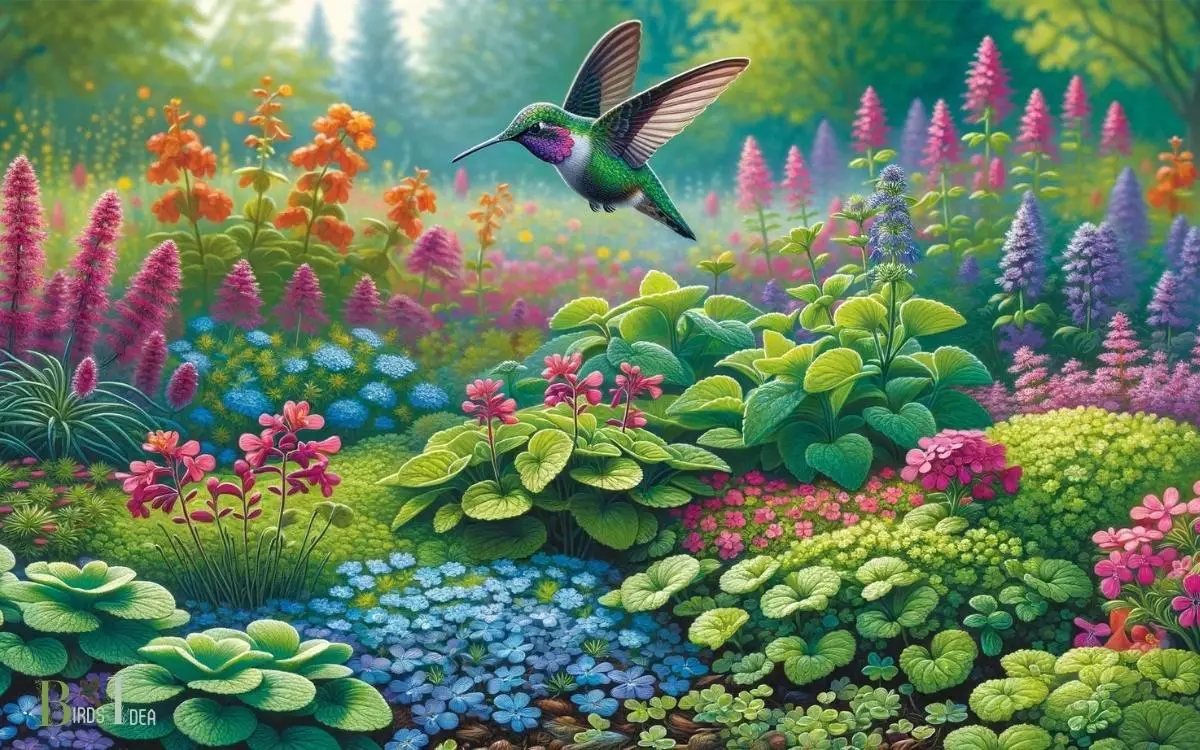Ground Cover That Attracts Hummingbirds: Discover!
Ground covers that attract hummingbirds provide both aesthetic appeal and ecological benefits to a garden.
Flowers such as creeping thyme, phlox, and sedum are excellent choices, as their vibrant blooms and nectar-rich flowers are irresistible to these tiny pollinators.
Hummingbirds are attracted to areas where they can find ample nectar to fuel their high metabolism.
Ground cover plants that produce ample flowers with nectar can provide a valuable food source for these birds.
Characteristics that typically attract hummingbirds include:
- Brightly colored blooms, especially red, pink, and orange
- Tubular flowers that accommodate a hummingbird’s long beak
- Plants that bloom for extended periods providing a consistent food source
Examples of hummingbird-friendly ground cover include:
Optimizing your garden with flowering ground covers can turn it into a hummingbird haven, providing both charm and a vital habitat for these enchanting birds.

Key Takeaway
Benefits of Hummingbird-Attracting Ground Cover
Hummingbird-attracting ground cover provides a low-maintenance way to attract these colorful birds to your garden.
By planting ground cover that hummingbirds love, you can create a welcoming environment for them to feed and nest.
These plants not only add beauty to your garden but also serve as a vital food source for hummingbirds.
Additionally, the ground cover can help in retaining moisture, preventing soil erosion, and suppressing weed growth. This means less work for the gardener and a more sustainable, natural habitat for the birds.
As the ground cover spreads and flowers, it creates a colorful and vibrant landscape that not only attracts hummingbirds but also adds a touch of natural charm to your outdoor space.
Best Types of Ground Cover for Hummingbirds
One can attract hummingbirds by planting certain types of ground cover that are known for their ability to draw in these colorful birds.
When selecting ground cover for hummingbirds, it’s important to choose varieties that provide nectar-rich flowers and a safe haven for these tiny creatures.
Some of the best types of ground cover for attracting hummingbirds include creeping thyme, bee balm, coral bells, and creeping phlox.
These plants not only offer a continuous supply of nectar but also create a low-growing, dense cover that can serve as nesting and foraging sites for hummingbirds.
Additionally, their vibrant blooms add beauty to the landscape while inviting these delightful birds to visit.
By incorporating these ground covers into the garden, enthusiasts can create an inviting environment for hummingbirds to thrive.
Planting and Maintaining Hummingbird-Friendly Ground Cover
When planting and maintaining ground cover for hummingbirds, it’s important to consider the ideal types of ground cover, as well as the specific soil and sunlight requirements.
Understanding the specific needs of hummingbirds will help ensure the success of the ground cover in attracting and sustaining these beautiful creatures in the garden.
By carefully selecting and maintaining the ground cover, gardeners can create a welcoming environment for hummingbirds while enhancing the overall beauty of their outdoor space.
Ideal Ground Cover
To create an ideal ground cover for attracting hummingbirds, gardeners should consider planting and maintaining low-growing, nectar-producing plants.
These plants should ideally be native to the region, as they are well-adapted to the local climate and soil conditions.
Some excellent choices for ground cover include creeping phlox, ajuga, and creeping thyme. When planting, it’s important to space the plants appropriately to allow for their natural spread and growth.
Regular maintenance such as watering, weeding, and occasional fertilization is essential to ensure the health and vigor of the ground cover plants.
Additionally, trimming or mowing the ground cover at the right time helps promote denser growth and more abundant flowers, which are essential for attracting hummingbirds.
By selecting and nurturing the right ground cover, gardeners can create an inviting habitat for these delightful birds.
Soil and Sunlight
The soil and sunlight conditions play a crucial role in planting and maintaining hummingbird-friendly ground cover.
Ensuring the right soil and sunlight conditions can greatly enhance the attractiveness of the ground cover to hummingbirds.
Here are some key points to consider:
Soil Type:
- Hummingbird-friendly ground cover thrives in well-draining soil with a slightly acidic to neutral pH.
- Consider amending the soil with organic matter to improve its texture and fertility.
Sunlight Exposure:
- Select ground cover plants that are suitable for the specific sunlight conditions in your garden.
- Ensure that the chosen area receives the appropriate amount of sunlight based on the ground cover’s sunlight requirements.
Maintenance:
- Regularly monitor the soil moisture and provide adequate watering, especially during dry periods.
- Prune the ground cover as needed to maintain its health and attractiveness to hummingbirds.
Designing a Hummingbird Garden With Ground Cover
Designers often incorporate low-growing plants as ground cover to attract hummingbirds to their gardens.
When designing a hummingbird garden, it’s essential to choose ground cover plants that provide nectar, shelter, and nesting material for these tiny birds.
Some excellent ground cover options for hummingbird gardens include creeping phlox, coral bells, and creeping thyme.
These plants not only add visual interest to the garden but also provide a food source for hummingbirds and attract insects, another essential part of the hummingbird diet.
Designers should consider the growth habits of the ground cover plants, ensuring they create a dense, low canopy that offers protection and foraging opportunities for hummingbirds.
By carefully selecting and arranging ground cover plants, designers can create a welcoming and functional hummingbird garden.
Seasonal Considerations for Hummingbird-Attracting Ground Cover
Seasonal changes necessitate careful selection of ground cover plants to maintain a consistent nectar and shelter supply for hummingbirds in the garden.
When considering seasonal variations, it’s important to keep the following points in mind:
Bloom Period
Choose a variety of ground cover plants with staggered blooming periods to ensure a continuous nectar supply throughout the seasons.
Planting a mix of early spring bloomers, summer-flowering plants, and fall bloomers can provide a year-round nectar source for hummingbirds.
Foliage Density
Select ground covers with dense foliage to provide shelter and nesting sites for hummingbirds, especially during the breeding season.
Evergreen ground covers can offer year-round shelter, while deciduous plants may be beneficial for providing nesting materials during the spring and summer.
Climate Adaptability
Consider the specific climate and microclimates in the garden to choose ground covers that can thrive and bloom throughout the changing seasons.
Researching native plants and their seasonal behavior can help in selecting the most suitable options for attracting hummingbirds year-round.
Additional Tips for Attracting Hummingbirds With Ground Cover
For hummingbird enthusiasts, creating an inviting environment with ground cover that attracts these fascinating birds can be achieved by strategically planting a variety of nectar-rich plants in their gardens.
Apart from selecting plants that bloom at different times to provide a continuous nectar supply, it’s essential to maintain a clean feeding area.
Regularly removing wilted flowers, debris, and old foliage helps in preventing mold growth and keeps the area attractive to hummingbirds.
Additionally, installing a shallow water feature near the ground cover can provide the birds with a water source for drinking and bathing.
It’s important to avoid using pesticides near the ground cover as they can be harmful to hummingbirds.
By following these additional tips, enthusiasts can enhance the attractiveness of their ground cover for hummingbirds.
Conclusion
As the garden blooms with vibrant ground cover, it becomes a stage for the graceful dance of hummingbirds.
Like a carefully choreographed ballet, the intertwining foliage and delicate flowers create a sanctuary for these enchanting birds.
By choosing the right ground cover and tending to its needs, one can invite these aerial performers to visit and bring a touch of magic to the garden.






